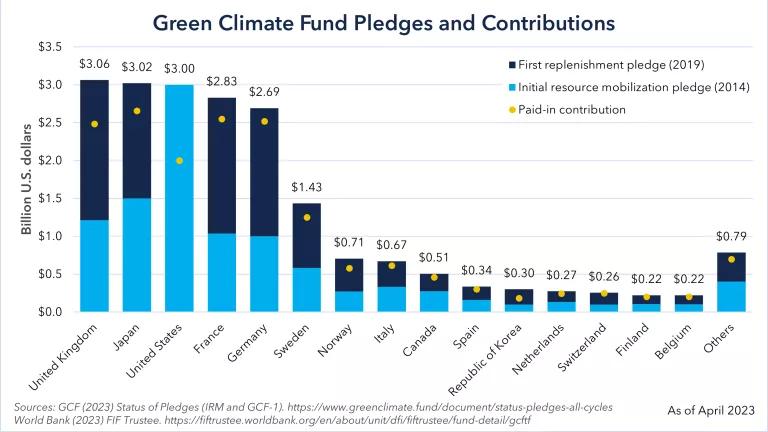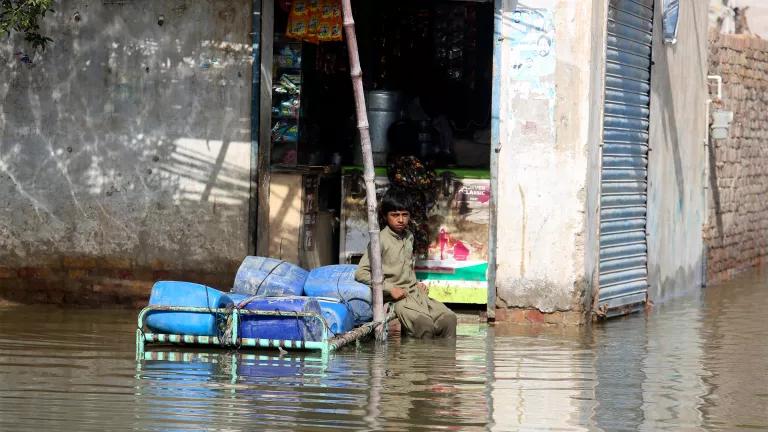Biden Budget Meets the Moment on Global Climate Investments
Congress should rally to realize this blueprint, including to rebuild confidence after its recently approved budget with anemic international climate investments.
The Biden administration unveiled a robust blueprint for international climate investments that can spur much-needed emissions reductions and help the most vulnerable adapt to the mounting impacts of the climate crisis. The president’s budget request for fiscal year 2023 (FY23) represents a step change commensurate with reinvigorating U.S. global leadership and protecting Americans and the international community against the physical, economic, and security threats of climate change. Congress should rally to realize this blueprint, including to rebuild confidence after its recently approved budget with anemic international climate investments.
Investing in Key Strategies to Tackle the Climate Crisis
President Biden’s budget includes a diverse set of strategies to mobilize key U.S. agencies and funds to drive investments that rapidly cut emissions this decade to keep the chance of holding global temperature increase to 1.5°C (2.7°F) alive. It also provides support to the most vulnerable communities around the world who are already facing disproportionate impacts of climate change, but have done the least to contribute to the problem.
Below is a break-down of the key international climate investments in the budget request, with more detailed funding proposals expected to be released over time:
- Overall: over $11 billion in total international climate finance with $5.3 billion in Congressional appropriations and more than $5.5 billion in development finance and credit programs.
- Bilateral climate programs through the Department of State and U.S. Agency for International Development: $2.3 billion.
- Green Climate Fund: $1.6 billion (which Congress must fund at a significantly higher level).
- Clean Technology Fund: a $520 million loan and a $30 million grant, leveraging $3.2 billion in overall investments.
- Clean Energy Manufacturing program: $200 million in mandatory funding (not accounted under Congressional appropriations) for the first year of a $1 billion Department of Energy program to build resilient supply chains for climate and clean energy equipment through engagement with other countries.
- Other agencies and funds: primarily the Millennium Challenge Corporation (MCC), Development Finance Corporation (DFC), Export-Import Bank (Ex-Im), and U.S. Trade and Development Agency investing the remainder.
Robust and sustained investments are a lynchpin of America’s global climate leadership, and ability to rally the world to address the climate challenge. America’s actions are more important than its words —and money drives real action. This funding request takes swift action to meet President Biden’s commitment at last year’s UN General Assembly to deliver $11.4 billion annually in international climate finance by 2024. According to the administration, this budget would help meet “the President’s pledge to quadruple international climate finance a year early.” This would bring the U.S. into greater alignment with its G7 partners, including the European Union that already contributes more than $24.5 billion per year in public climate finance with an economy smaller than the U.S.
Critical Investments that Advance America’s Interests
These investments serve several critical needs to address the climate crisis by:
- providing a key cornerstone of America’s ability to rally the world to address the climate crisis;
- helping spur global actions necessary to reduce emissions quickly enough to keep 1.5°C (2.7°F) within reach;
- supporting the poorest countries in the world that have contributed very little to climate change, yet are already facing disproportionately dire impacts; and
- creating opportunities for American companies and entrepreneurs in the burgeoning global clean energy market.
First, bilateral climate programs provide critical support to adapt to the impacts of a changing climate. $2.3 billion represents a significant and increased investment from current funding levels.
Importantly, bilateral programs support developing countries in adapting to the impacts of the climate crisis – a top priority of vulnerable countries that have contributed very little to climate change, yet are disproportionately affected by its mounting impacts. Investments in adaptation help reduce the impact of severe weather and climate-fueled disasters on critical infrastructure, agricultural productivity, and public health in these countries. Just the top 10 climate events in 2021 cost the world $170 billion in insured losses, with the full tally coming in much higher. And global disaster response efforts demonstrate that investing $1 today helps avoid around $7 in spending needed after a disaster hits. The U.S. and other donor countries must seek a balance between mitigation and adaptation investments, as adaptation receives only around a quarter of current funding.
Bilateral programs also spur renewable energy markets globally and protect critical carbon-storing landscapes including forests. These investments increase energy access and security in developing countries, creating markets for American renewable energy companies and leveraging private sector investment. The global clean energy market in emerging economies is estimated at $23 trillion by 2030, creating a massive and relatively untapped opportunity for American companies. Smart U.S. investments can help unleash trillions in private sector finance to tackle the climate crisis. The programs also incentivize developing countries to curb deforestation and illegal logging, addressing rural poverty and improving how forests and lands are managed.
The Green Climate Fund is the world’s largest and most innovative environmental and conservation fund. It facilitates transformative investments that reduce emissions, help poorer countries adapt to climate impacts, and minimize the climate damages faced by Americans from all walks of life. The GCF is based on bipartisan economic principles, with every dollar the U.S. invests leveraged many times over by other donors and the private sector. The GCF creates opportunities for American companies and workers to export technologies and innovations into the burgeoning global clean energy market and create good-paying jobs.
In 2014, the Obama Administration pledged an initial $3 billion to the Green Climate Fund, of which only $1 billion has been provided to date. The U.S. must deliver the remaining $2 billion in funding immediately, and commit to and begin delivering in earnest on a doubled GCF commitment from what it initially pledged. Many of the U.S.’s closest partners, including Germany and the U.K., have announced pledges to double their initial GCF contributions over the last several years and are well on their way toward fulfilling them. China has also pledged $3.1 billion to assist developing countries in addressing climate change.
Now Congress and the Biden Administration Need to Deliver
We have a limited window to tackle the climate crisis, with the need for decisive action this decade to keep open the possibility of holding global temperature rise below 2.7°F (1.5°C). International clime investments advance vital U.S. interests by promoting global stability and security, creating economic opportunities for U.S. businesses and workers, alleviating global poverty, safeguarding other U.S. development efforts, and ensuring significant cost-savings through disaster preparedness measures.
The U.S. final fiscal year 2022 (FY22) funding bill was a major disappointment in terms of international resources to tackle the climate crisis. The President requested $2.5 billion, but the final investment was only a mere $1 billion in direct financing. This year’s budget needs to rise to the moment and deliver the kind of investments that drive the needed climate transformations during this decisive decade.
President Biden’s proposed robust investments in clean energy and international climate action would go a long way to cutting greenhouse gas emissions in line with what science demands and the most vulnerable people need to adapt to destructive climate impacts they didn’t cause and can’t avoid. If enacted, this would help overcome Congress’ recently approved anemic international climate funding, and all parties should rally around this plan.
It is time to finally rise to the moment of the global climate crisis.




